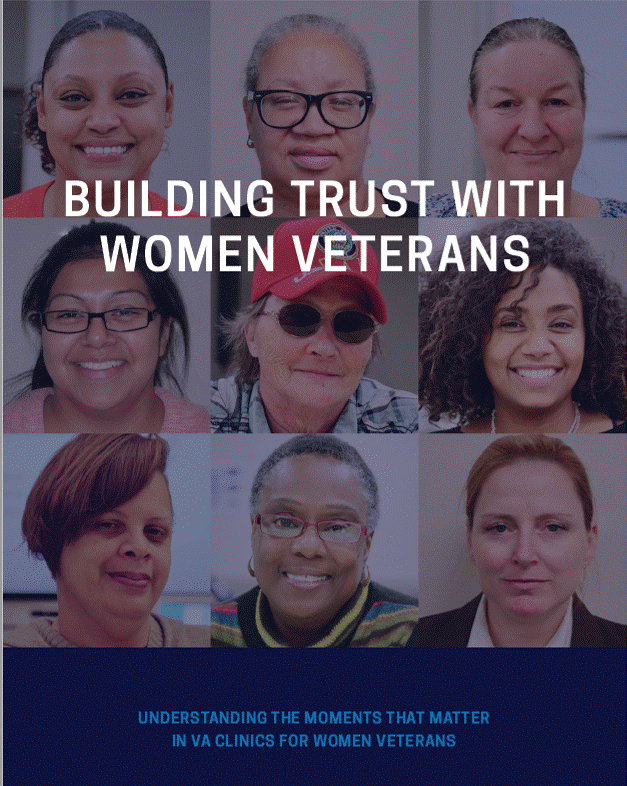VERONICA X. VELA
Advancing Population & Community Health
Through Innovative Problem Solving
BUILDING TRUST WITH WOMEN VETERANS
THE CHALLENGE
Women veterans are an expanding population and here to stay. They are the fastest growing demographic group of veterans in the United States. Currently, they make up 2 million or 9.5% of the 20 million living veterans today. While the number of veterans overall is decreasing, the number of women veterans is increasing rapidly. The continued rise will place more demands for women veteran healthcare services.
Annual surveys indicate that women veterans have lower trust scores than men. To understand why, the Center for Women Veterans, Women’s Health Services and the Veterans Experience Office (VEO) teamed up to explore how women currently experience outpatient care. What can VA do to rebuild trust with women veterans as they seek and receive care at VA medical centers and clinics?
MY ROLES
Design Research Lead
Design Strategy
Content Strategy & Design
RESEARCH QUESTIONS
RESEARCH QUESTIONS
We sought to understand how women veterans experience care at VA relative to the broader sample in the original patient experience project, which included both men and women.
-
What are the unique moments that matter to women veterans as they seek and receive care from VA?
-
Why do these moments matter?
-
Where should VA focus its improvement efforts to better serve women?
.jpg)
Photos: Aaron Stenstra
APPROACH
APPROACH
We traveled to North Carolina to talk with women at two VA medical facilities. In order to clear the path for our visit, we partnered with national, regional and local women's health leaders to design the workshops. They cleared roadblocks, informed local staff and helped us recruit women to participate in the workshop.
-
We facilitated 2 workshops
-
We focused on women who received care from VA in the last 60 days - we wanted their memories to be recent
-
We made sure to included combat veterans
-
We designed an interactive workshop that incorporated individual, pair and group activities










I want you to treat me like a whole person, not just someone assigned to you.
Katherine, Age 45
Durham, NC

I am on my third hand-off in two years. The process takes too long and requires a long wait time, a retelling of my very long and complicated history which the doctor never seems to take time to review before my first appointment. It is stressful, shows a lack of initiative and concern for patients on the provider’s part and almost never fosters a healthy connection between me and my provider.
Tera, Age 38
Fayetteville, GA
SYNTHESIS
SYNTHESIS
We conducted synthesis after each session, then cumulatively, at the end. After each workshop, we brought int local leaders to participate in the synthesis, who helped us digest what we heard. While they were not present in the actual workshops, their insights and appreciation for what we heard was immensely valuable to making sense of the information. Together we developed key themes and recommendations at the national, regional and local level.
During our cumulative synthesis, we combined the findings from the two sessions. We also drafted prototypes for our artifacts and gathered feedback from our project sponsors.
WHAT WE LEARNED
WHAT WE LEARNED
We learned that women's history of military sexual trauma or other life traumas that impact women's care experiences at VA.
-
Women veterans need empathy, compassion and responsive customer service at every step of the way.
-
They need to feel connected to their provider in order to trust the care they receive.
-
Women veterans are disappointed when they notice men and VA employees getting better treatment.
-
Women's care needs are not being addressed and many services are unavailable despite VA policy requirements.
-
Women Veterans want to be involved in the care design process to help VA improve care for all Veterans.
ARTIFACTS
-
Building Trust with Women Veterans Empathy Video
-
Building Trust with Women Veterans Storybook
-
Women Veterans Patient Experience Journey Map
-
Design Opportunities Matrix
Video/Audio Production: Sarah Hughes, Aaron Steinstra
Visual Design: Deloitte Dobline, Aaron Steinstra, Veronica Vela, Chakakhon Lea
Visual Design: Deloitte Doblin, Aaron Steinstra, Veronica Vela, Chakakhon Lea
Visual Design: Aaron Steinstra, Veronica Vela
OUTCOMES
This project culminated in a workshop to identify the top design opportunities to build trust with women veterans. The work is ongoing and design teams are working to improve the provider-patient relationship.







